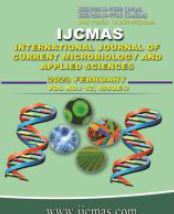


 National Academy of Agricultural Sciences (NAAS)
National Academy of Agricultural Sciences (NAAS)

|
PRINT ISSN : 2319-7692
Online ISSN : 2319-7706 Issues : 12 per year Publisher : Excellent Publishers Email : editorijcmas@gmail.com / submit@ijcmas.com Editor-in-chief: Dr.M.Prakash Index Copernicus ICV 2018: 95.39 NAAS RATING 2020: 5.38 |
Background: An individual's health is largely determined by nutrition, and nutrition is determined by diet, which consists of a variety of food items. As a result, eating a well-balanced and healthy diet is the single most significant element in achieving and maintaining good. The health of an individual depends to a large extent on nutrition and nutrition depends on diet, which consists of various articles of food. Hence balanced and nutritious food is the most important single factor in connection with the attainment and maintenance of health. Objective: 1) To study Nutritional deficiency disorders among the tribal population. 2) To study the composite nutritional value as per the given Weightage. 3) To examine the pattern of diet and nutrition and their availability and intake in study regions. Methods: Statistical and cartographic techniques have been used for the research work to precise conclusions. Per head per day availability foodstuff stuffs like, cereals, pulses, milk, vegetables etc. has been finding out and shown through PHC wise isopleths maps. PPHC-whisper head per day consumption has been calculated through the sample village survey. A total of 115 villages are chosen, and 23 villages from the list of ITDP villages have randomly chosen in each tehsil. By using a probability proportional to the size of the various tribes, a total of 10 households (HHs) from each chosen village have been covered. Result: The cumulative nutritional values of cereals are derived from the total of all weight ages measured so far. The composite nutrient values for cereals were 14.72 in Peint tehsil. This method was used to quantify the composite nutrient value for pulses, edible oil, milk, vegetables, and fruits. The cumulative composite value of Peint tehsil was 67.22 when the composite nutrition values were added together. The table shows the cumulative composite nutrition values measured on a tehsil-by-tehsil basis. Conclusion: The indigenous inhabitants of the study region eat jowar, maize, wheat, and bajara as their major foods. Despite the fact that the terrain is conducive to rice farming, they still consume rice on occasion. Pulses are a staple of indigenous people's diets, which they consume on a daily basis. However, they consume very little fat-containing foods such as oil and milk in their regular diet. Similarly, just a small percentage of households include fruits and vegetables in their daily diet. These people are unable to acquire such expensive items due to their poverty. The general nutritional status is measured by computing composite nutrition values. For the entire region, the average composite nutrition value is 74.81.
 |
 |
 |
 |
 |